How Americans see the Dutch
When I posted about how the Dutch see the Americans, it wasn’t particularly complimentary, so I promised to write the opposite post: how the Americans see the Dutch.
(Nederlands vertaling beneden)
Disclosure: This article contains affiliate links. If you click on one of them and spend money, I will receive a small percentage of what you spend. This will not affect your price.
Here’s the problem: the Americans don’t see the Dutch. What I mean is that America is big and Holland is small, and, for the most part, the Americans don’t pay any attention to Holland. Picture an elephant with a fly buzzing around it. Holland is the fly.
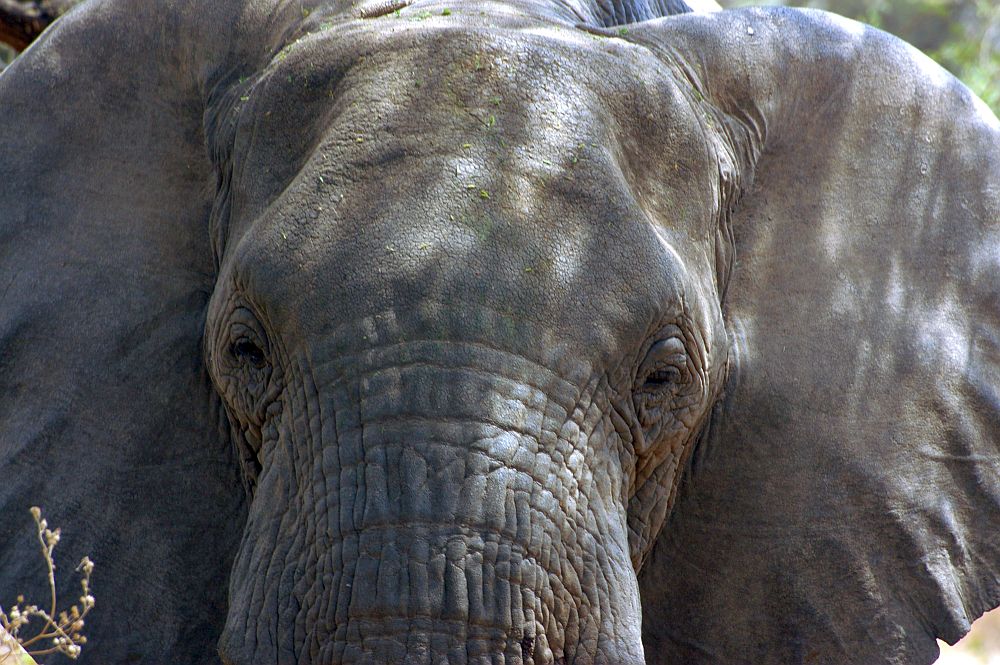
Nevertheless, when I posed the question on Facebook, I did get some responses, so here it is: how the Americans see the Dutch.
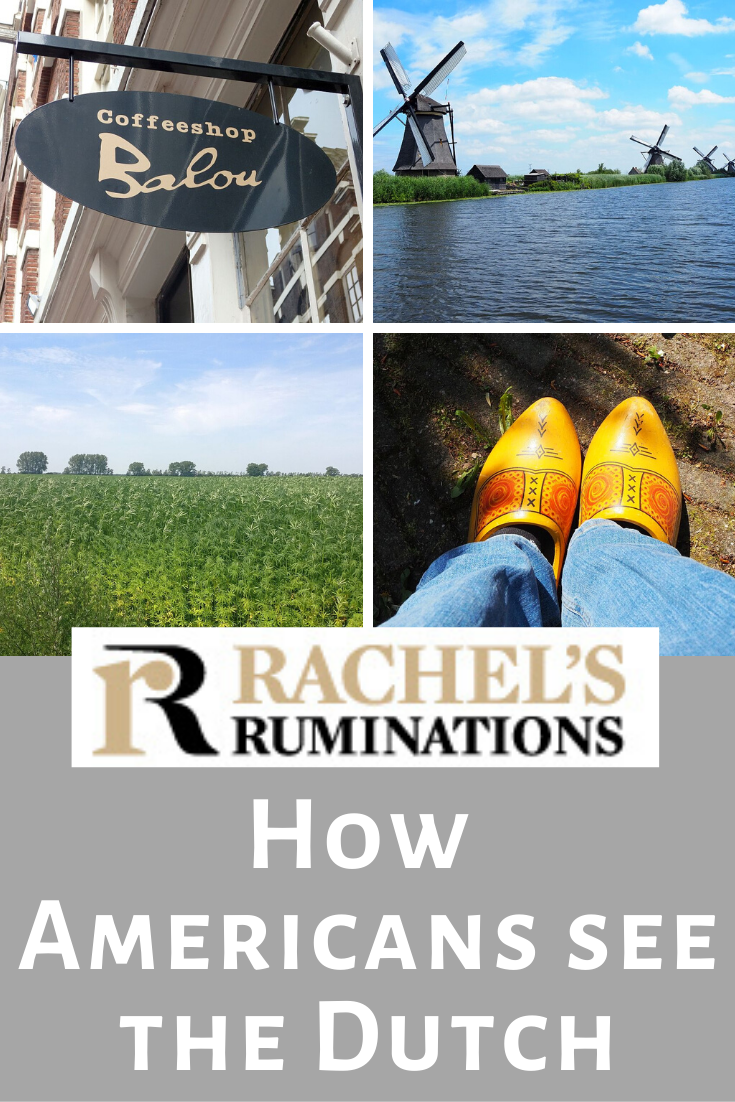
Most of the comments I’ve heard were about 1) drugs and 2) prostitution, so I’ll start with those.
1. Drugs
One image of the Dutch is that they do drugs a lot, especially marijuana. It’s available on every street corner, and everyone, young and old, smokes it regularly.
This view of the Dutch is particularly ironic, given that the drug use and abuse statistics are worse in the US. The use of cannabis (annual prevalence of use as a percentage of the population) in the US is 13.7 percent, while in the Netherlands, it’s 5.4 percent, according to the United Nations Office on Drugs and Crime. The difference could decrease, it seems to me, now that some US states are legalizing marijuana.
Marijuana is indeed legal here. Well, not exactly legal, but tolerated. And it is widely and easily available.
Instead, law enforcement focuses on finding the large-scale drug smugglers. Recently, the government has begun to allow legal marijuana cultivation as a way to defeat the drug smugglers as well as to ensure the quality of supply to the “coffee shops.”
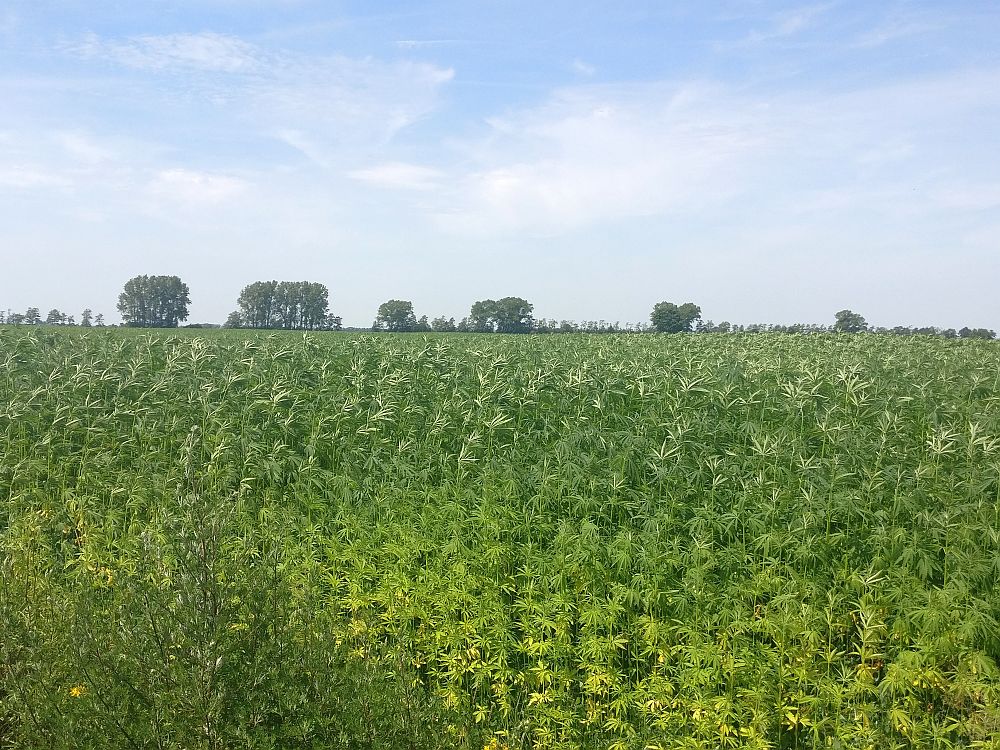
Factoid: If you’re just looking for a cup of coffee, go to a cafe, not a coffee shop. A “coffeeshop” sells marijuana. You can recognize a coffeeshop just from the general smell as you walk by on the street. They’re often decorated with the Jamaican national colors: red, green and yellow.
This is a typical case of Dutch pragmatism. The idea is that people are going to use drugs, so keeping a soft drug like marijuana in the open makes its use safer and easier to regulate. This way the quality of the product is reliable, not laced with other, possibly dangerous, substances, and the shop owners pay taxes and follow regulations just like other shop owners.
The sale is regulated, by the way. “Coffeeshop” owners can’t have too much product on the premises at any one time. Some cities regulate the location of the shops, so they can’t be within a certain number of meters of a school. Some of the border cities have been experimenting lately with making them “members only” in order to reduce the drug tourism that can be a problem there.
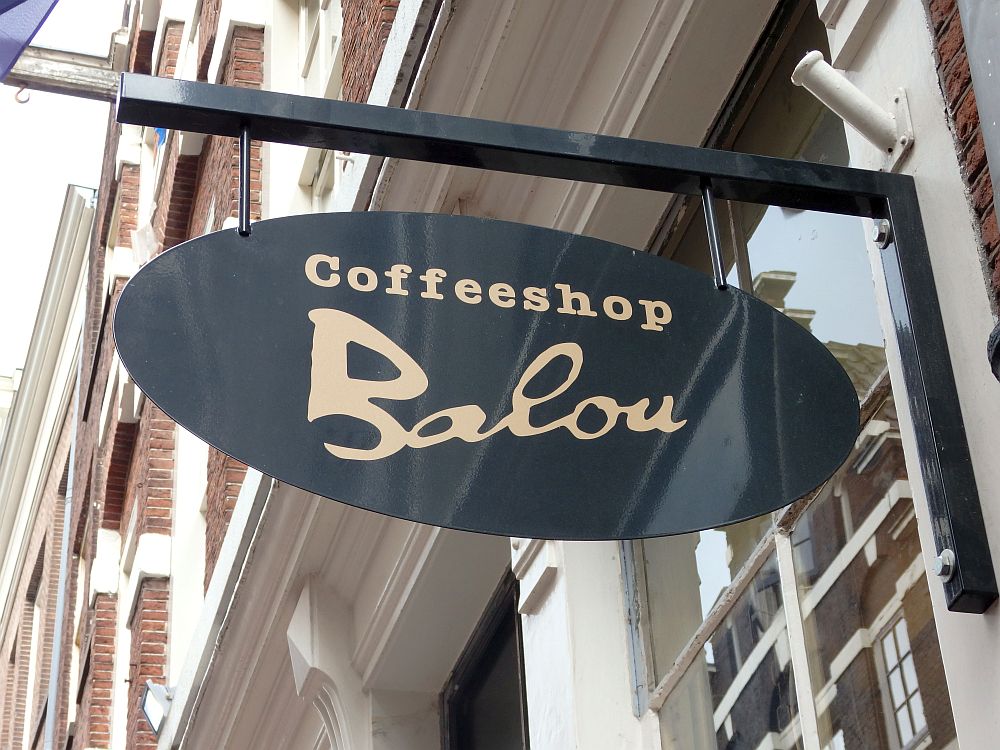
If you want marijuana at home, you can even order it to be picked up from the coffeeshop and delivered to your home by motorbike. Isn’t that civilized?
To learn all about marijuana, visit the Hash, Marijuana and Hemp Museum in Amsterdam. Click here to buy tickets.
2. Prostitution
Another view of the Dutch is that they go to prostitutes a lot. I’m not sure if this stereotypes includes women: do Americans think that both men and women go to them?
Anyway, I don’t know if the Dutch go to prostitutes a lot; that’s not the kind of statistic that’s easy to come by. It certainly is tolerated. Any city of any size has a “red light district” (Yes, they involve actual red lights.). The industry is, at least theoretically, open and regulated, with prostitutes getting tested regularly for STDs, paying taxes, and generally conforming to the law.
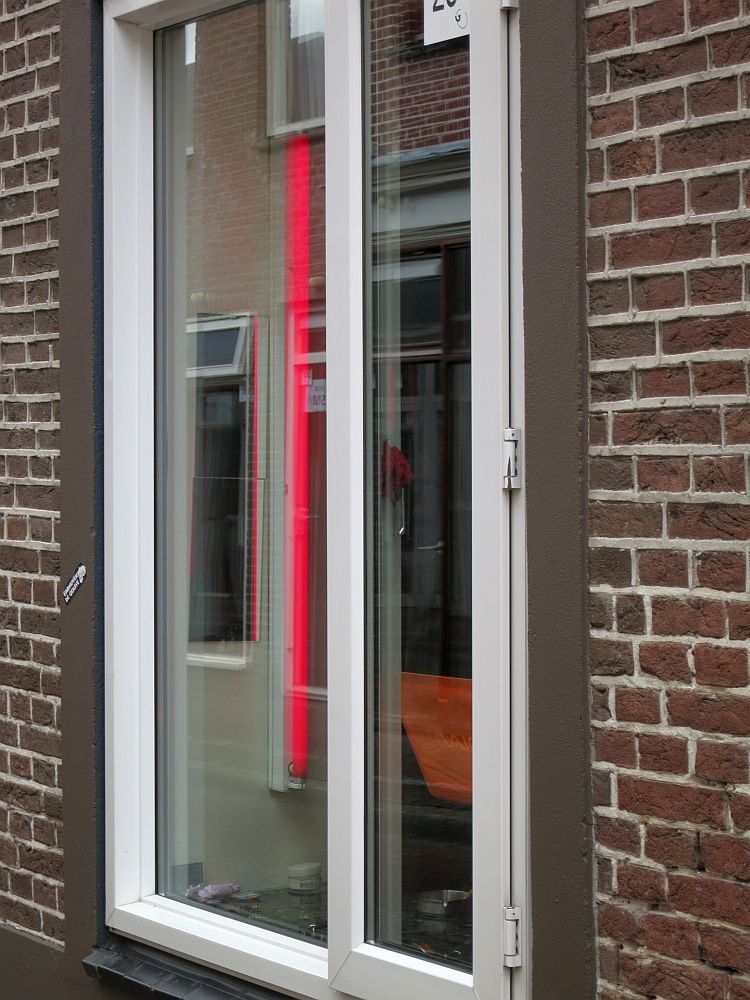
Prostitutes pay rent for the window and the room behind it. The rent is controlled by law, and, in theory, the owner of the building has to do things like make his records available to the prostitutes and comply with other regulations to ensure their safety.
In reality, though, human trafficking has become a big part of prostitution in the last few decades, and the common image of the “happy hooker” doesn’t seem to be true, if it ever was. Some prostitutes nowadays are forced into it, either by a pimp or by the circumstances of being brought here as, essentially, slaves.
Here’s another factoid for you: the original “Happy Hooker” was a Dutch woman.
Nevertheless, the openness with which it is treated is, again, a case of Dutch pragmatism. Reacting punitively would only drive the industry underground, and that would be even more dangerous for the women involved.
You can learn all about prostitution in the Netherlands at Red Light Secrets Museum of Prostitution in Amsterdam. Tickets are available here.
3. Where is Holland?
Generally, Americans don’t know where the Netherlands is. This is partly the fault of the Dutch, since they don’t seem to know what to call the place: are they Holland or the Netherlands? This video sorts this out clearly, if rather quickly:
However, among Americans, there’s also a general confusion not about the name of the place, but about where it is on the map. Just a few examples I’ve heard:
- “Holland? Is that near Amsterdam?”
- “Holland? Is that near Europe?”
- “The Netherlands? Is that near Holland?”
- “The Netherlands? That’s part of Germany, right?”
4. Clogs
Dutch people wear clogs (and those funny white hats too).
Sorry to disappoint, but that’s pretty much only true for farmers; the thick wooden sole keeps their feet dry when they have to walk on mud. And the white hats? No.
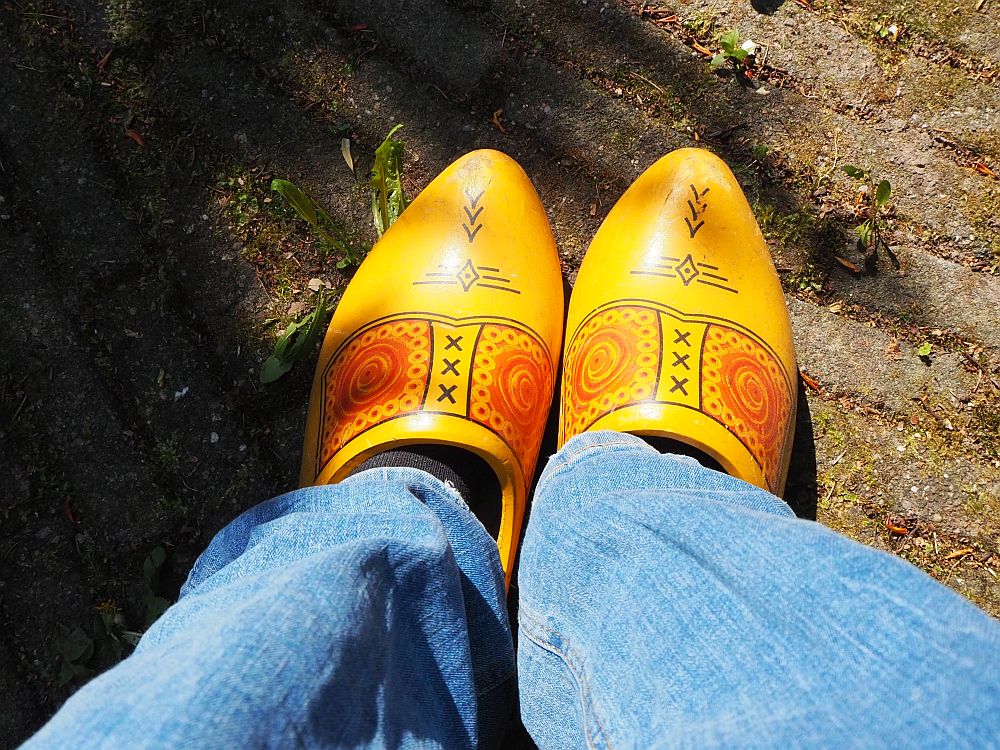
5. Windmills and tulips
Yes,Holland has a lot of windmills, but so do lots of other countries: the US, for example! And the same goes for tulips. They grow a lot of tulips here, but then sell the bulbs all over the world, so tulips grow in lots of other places too.
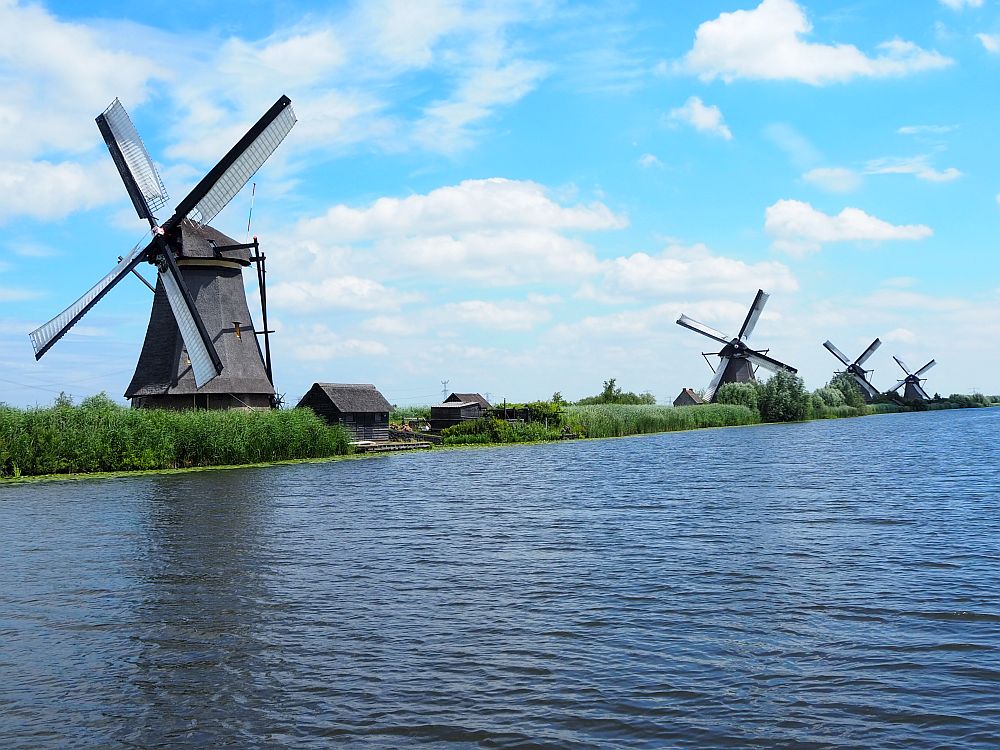
Another couple of factoids: tulips originated in Turkey and/or Iran. The tulip mania in Holland in the 1600s led to an economic bubble based on extreme prices for bulbs. Read more about that in my article about the Tulip Museum in Amsterdam.
If you’d like to see the windmills at Kinderdijk, book your tickets ahead so you don’t waste your time waiting in the ticket line!
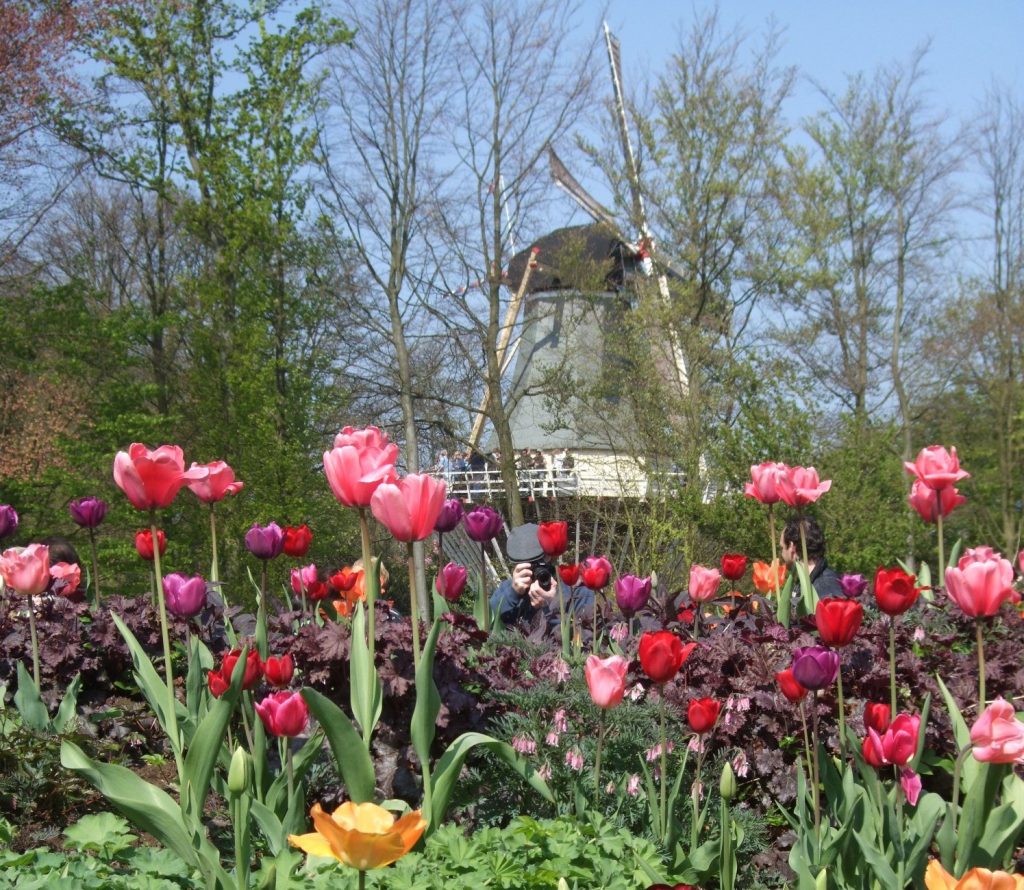
If you come visit the Netherland, there are two great places to see windmills: Kinderdijk, which is a UNESCO site, and Zaanse Schans, which is less well known but which I like better. I wrote a comparison here.
6. The boy with his finger in the dike
and
7. Hans Brinker
Surprisingly, not many Dutch people have ever heard either of these stories. Apparently they were an invention of an American author named Mary Mapes Dodge. Hans Brinker, or The Silver Skates is set in Holland and tells the story of a boy who wins a pair of silver skates by winning a skating race. Somewhere within Dodge’s book is a story within the story about a boy who discovers a hole in a dike and spends the whole night out in the cold with his finger in the hole in order to save his village.
Sorry to disappoint you, Americans. A hole in a dike would not be pluggable with a finger, and Hans Brinker never existed. However, the Dutch are just as crazy about skating as the fictional Hans. The vision you have of the Dutch skating on canals is mostly not true either; they love to do it, but it only freezes enough for that to happen once or twice each winter.
And there are indeed dikes everywhere, which is necessary considering that 26 percent of the country is below sea level. It won’t come as a surprise, then, that the Dutch are the world’s experts in water control.
8. Beautiful, statuesque women with blue eyes and blond hair and killer cheekbones
I’ll concede that this stereotype is often true. Though, again, it needs some nuance. While the Dutch are tall on average, immigration over the last 50 years or so is bringing other ethnicities into the mix, which will eventually bring the average height down, I’m sure.
One more factoid: The Dutch are the tallest nation in the world after the Masai of East Africa.
American readers, is there anything I’ve missed about your view of Holland, (or the Netherlands, or whatever else you want to call it)? If so, please post it below!
Below the pinnable image, you’ll find the same article in Dutch.
Onder het beeld zul je de Nederlands vertaling vinden:
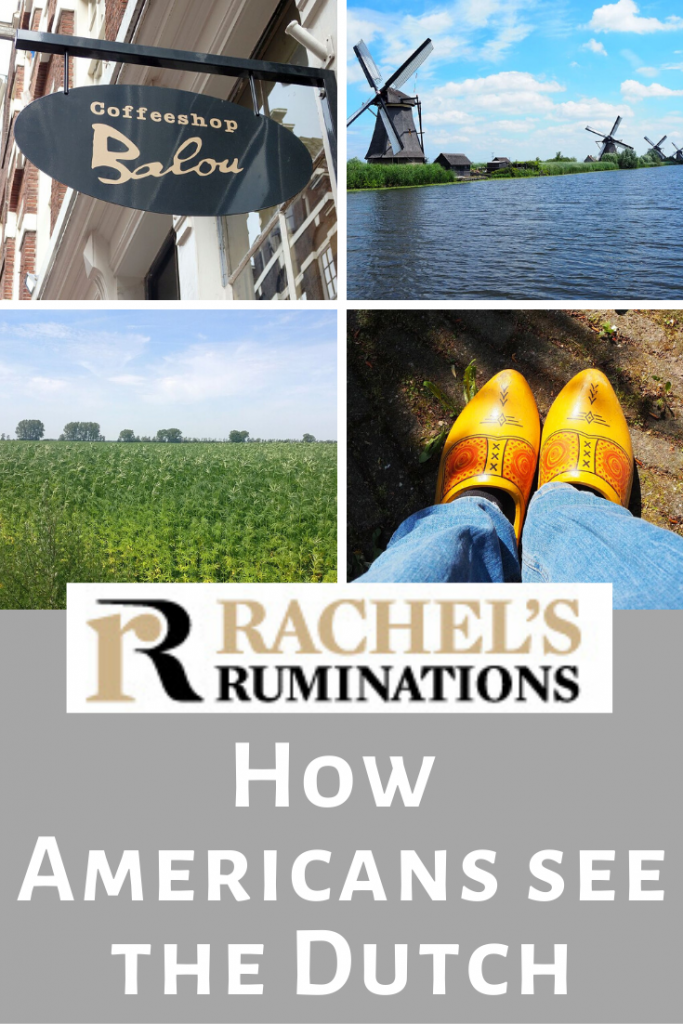
Hoe de Amerikanen denken over Nederlanders
Eerder heb ik geschreven over hoe Nederlanders de Amerikanen zien. Het was niet bijzonder vleiend, dus beloofde ik om een tegenovergestelde post te schrijven: hoe de Amerikanen denken over Nederlanders.
En dan heb ik een probleem: de Amerikanen denken niet over Nederlanders. Wat ik bedoel is dat Amerika groot is en Nederland klein, en, voor het grootste deel, besteden de Amerikanen geen aandacht aan Holland. Je kunt het je voorstellen als een olifant waar een vlieg rond zoemt. En dan is Holland de vlieg.
Niettemin, toen ik de vraag stelde op Facebook kreeg ik wat reacties, dus hier is het: hoe de Amerikanen denken over Nederlanders. De meeste van de opmerkingen die ik kreeg gingen over 1) drugs en 2) prostitutie, dus ik zal beginnen met deze twee.
1. Drugs
De Nederlanders gebruiken veel drugs, vooral marihuana. Het is beschikbaar op elke straat, en iedereen, jong en oud, rookt het regelmatig.
Dit beeld van Nederland is bijzonder ironisch, gezien het feit dat het drugsgebruik en misbruik statistisch gezien slechter is in de Verenigde Staten. Het gebruik van cannabis (de jaarlijkse prevalentie van het gebruik als een percentage van de bevolking) in de VS is 13,7 procent terwijl dat in Nederland 5,4 procent is, volgens het VN-Bureau voor Drugs en Misdaad.
Marihuana is hier inderdaad legaal. Nou, niet echt legaal, maar het wordt gedoogd. Het is op meerdere plekken te verkrijgen en je kunt er dus makkelijk over beschikken. In plaats daarvan richt de rechtshandhaving zich op het vinden van de grootschalige drugssmokkelaars.
Dit is een typisch geval van Nederlandse pragmatisme. Het idee is dat mensen drugs gaan gebruiken, dus het legaal houden van soft drugs zoals marihuana maakt het gebruik ervan veiliger en makkelijker te reguleren. Op deze manier wordt de kwaliteit van het product betrouwbaarder, niet doorspekt met andere, mogelijk gevaarlijke stoffen, en de winkel eigenaren betalen belastingen en volgen de regelgeving net als andere winkeliers.
Trouwens, de verkoop wordt wel gereguleerd. Winkeliers mogen maar een klein hoeveelheid in de winkel hebben. Sommige steden beheren de locatie van de winkels, zodat zij niet binnen een bepaald aantal meters van een school komen. Enkele grenssteden hebben onlangs geëxperimenteerd met verplichte lidmaatschap aan de winkels om het drugstoerisme tegen te gaan.
Een tip: als je Nederland bezoekt en een bord op een winkel ziet waar “coffeeshop” op staat, is dat waar ze marihuana verkopen. Als je koffie wil, ga dan naar een café. Je kan ook een coffeeshop herkennen aan de algemeen bekende geur als je door de straat loopt. Ze zijn vaak versierd met de Jamaicaanse nationale kleuren: rood, groen en geel. Als je marihuana thuis wil, kan je dit zelfs bestellen en het wordt uit de coffeeshop gehaald en met de motor naar je huis bezorgd. Is dat niet beschaafd?
2. Prostitutie
De Nederlanders gaan veel naar prostituees.
Ik weet niet zeker of deze stereotypen inclusief vrouwen is: denken Amerikanen dat zowel mannen als vrouwen naar prostituees gaan? Hoe dan ook, ik weet niet of Nederlanders veel naar prostituees gaan; dat is niet het soort van statistiek dat makkelijk is te vinden of aan mensen te vragen is.
Het wordt zeker getolereerd. Elke stad van enige omvang heeft een “red light district” (Ja, ze gebruiken werkelijke rode lichten.). De industrie is, althans in theorie, open en gereguleerd en prostituees worden regelmatig getest op soa’s, ze betalen belastingen, en in het algemeen voldoen ze aan de wet.
In werkelijkheid echter, is mensenhandel uitgegroeid tot een groot deel van de prostitutie in de afgelopen decennia, en het gemeenschappelijke beeld van de ‘happy hooker’ lijkt niet waar te zijn, als dat er ooit was. (Hier is een feitje voor je: de oorspronkelijke ‘Happy Hooker’ was een Nederlandse vrouw.) Veel, misschien wel de meeste prostituees tegenwoordig worden gedwongen, hetzij door een pooier of door de omstandigheden waarin zij leven doordat ze naar Nederland gebracht zijn. Zij leven, in wezen, als slaven.
Niettemin is de openheid waarmee het behandeld wordt, wederom, een geval van Nederlandse pragmatisme. Reageren als strafmaatregel zou alleen de industrie ondergronds sturen en dat zou nog gevaarlijker zijn voor de betrokken vrouwen.
3. Waar is Holland?
In het algemeen, weet de Amerikanen niet waar Nederland is. Dit is deels de schuld van de Nederlanders zelf omdat ze niet lijken te weten hoe zij hun land moeten noemen: zijn ze Holland of Nederland? De video (boven) legt dit duidelijk uit.
Echter, onder de Amerikanen, is er een algemene verwarring over én de naam van de plaats, én waar het ligt op de kaart. Slechts een paar voorbeelden die ik heb gehoord:
- “Holland? Is dat in de buurt van Amsterdam? “
- “Holland? Is dat in de buurt van Europa? “
- “Nederland? Is dat in de buurt van Holland? “
4. Clogs
Nederlanders dragen klompen (en die grappige witte hoeden ook).
Sorry om je teleur te stellen, maar dat is vrijwel alleen waar voor boeren; de dikke houten zool houdt hun voeten droog als ze op modder moeten lopen. En de witte hoeden? Nee.
5. Molens en tulpen
Ja, Holland heeft veel windmolens, maar die hebben veel andere landen ook: de VS, bijvoorbeeld! En hetzelfde geldt voor tulpen. Ze kweken veel tulpen hier, maar om de bollen te verkopen over de hele wereld, daarom groeien tulpen in tal van andere landen ook. (Nog een paar feitjes: Tulpen zijn in Turkije en/of Iran ontstaan. De tulpenmanie in Nederland in de jaren 1600 leidde tot een hausse op basis van extreme prijzen voor bollen.)
6. De jongen met de vinger in de dijk
en
7. Hans Brinker
Niet veel Nederlanders hebben wel eens gehoord van deze verhalen. Blijkbaar waren ze een verzinsel van een Amerikaanse auteur, Mary Mapes Dodge. Hans Brinker, or The Silver Skates vindt plaats in Nederland met het verhaal van een jongen die een paar zilveren schaatsen wint door een schaatswedstrijd te winnen. Ergens binnen Dodge haar boek is een verhaal binnen het verhaal van een jongen die een gat in een dijk ontdekt en de hele nacht in de kou doorbrengt met zijn vinger in het gat om zijn dorp te redden.
Sorry dat ik jullie teleurstel, Amerikanen. Een gat in een dijk is niet dicht te maken met een vinger en Hans Brinker heeft nooit bestaan. Echter, de Nederlanders zijn net zo gek op schaatsen als de fictieve Hans. Het beeld dat je hebt van schaatsen op de grachten is helaas niet vaak te zien; Nederlanders houden ervan om het te doen, maar het vriest zo zelden dat het maar een of twee keer per winter gebeurt. En er zijn inderdaad dijken overal, wat noodzakelijk is gezien het feit dat 26 procent van het land onder de zeespiegel ligt. Natuurlijk zijn de Nederlanders wereld experts in het waterbeheersing.
8. Mooie, statige vrouwen met blauwe ogen, blond haar en killer jukbeenderen
De “big-bosomed lady with a Dutch accent” van Rod Stewart zijn liedje is inderdaad vaak waar. Hoewel, nogmaals, het heeft wat nuance nodig. Terwijl de Nederlanders gemiddeld lang zijn (feitje: langste van de wereld na de Masai in Oost-Afrika), heeft de immigratie in de afgelopen 50 jaar andere etniciteiten in de mix gebracht, die uiteindelijk de gemiddelde lengte naar beneden zullen halen.
Amerikaanse lezers, is er iets wat ik gemist heb over je beeld van Holland, (of Nederland, of wat je het ook wilt noemen)? Zo ja, dan laat een bericht hieronder!


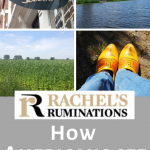

The best thing is that there is an area in Michigan (around the town of Holland, near Lake Michigan) that is more traditionally Dutch than all of the Netherlands. Yes, there you can find people wearing clogs and white hats. There is a tulip festival and they have a fully functioning windmill. Even the ‘klompendans’ is still a big thing there. Surnames like De Boer (yes, WITH a space in between the two words!) and Hoekstra are perhaps as common as they are in The Netherlands. Travel Channel did a piece about the area not long ago and I learned more about Dutch tradition than I did growing up here..
There’s a word for that phenomenon, but I only know it in Dutch: revitalisering. Maybe “revitalizing” in English? It means the tendency of immigrants to hang onto aspects of their original culture, but then, over time, the cultural practices in their original country gradually change, which is natural. So their view of “life in Holland” matches the way life in Holland used to be when they emigrated. Most the people in that area in Michigan emigrated back in the late 1940’s and 50’s, right? There’s a similar town outside of Bellingham, Washington I visited last year that was settled by Dutch immigrants. It was fun to visit with a group of Dutch students! Anyway, thanks for posting, Anneke!
Great post! I admit, I had a few stereotypes . . .and you were able to dispel them quite nicely. Plus, I know I didn’t know the difference between Holland and the Netherlands! Thanks!
I know we’re all supposed to be battling stereotypes and stereotyping, but sometimes it’s just fun to step back and look at them. Thanks for your comment!
I’m glad you’ve tried to set the record right about Holland or The Netherlands in your blog post Rachel. There is so much that one can write about this progressive nation in Europe.
I may be biased because I had Dutch classmates while studying in Jakarta and the mentor who guided my early career was Dutch but here are some facts that I can add, from experience and knowledge
1. Schipol Airport is the hub for many European flights and is known as a great airport for Duty-Free shopping in that part of the world – their prices are the best. 😉
2. The Dutch East India Company established trading settlements in India between 1605-1825 but later shifted their interest towards the Dutch East Indies, known as Indonesia.
3. The Dutch conquered Ceylon (Sri Lanka) from the Portuguese but lost it in the aftermath of the Napoleonic Wars
4. The three Anglo-Dutch Wars of the 17th century left the Dutch as the dominant naval and trading power in Asia.
5. Hostilities between England & Holland ceased after the Glorious Revolution of 1688, when the Dutch prince William of Orange ascended the English throne, bringing peace between the Netherlands and England.
If nothing else, the Netherlands/Dutch Team has shown that they can win against Football Powers in the current World Cup 2014.
A long comment to your post Rachel, but I am inspired!
I’m glad you felt inspired! Thanks for adding to my list of factoids! Maybe I’ll do a separate post at some time in the future with more interesting facts about Holland… see, now you’ve inspired me!
Nice to see a measured response.
I especially liked your reference to their pragmatism.
They are incredibly pragmatic in lots of ways; that’s a future post as well! Thanks for commenting!
Funny, i know that coffeeshop in the picture.
From the outside or the inside? ;o)
Hi 🙂
The Dutch don’t go to prostitutes alot. Prostitution is only regulated, like marijuana.
Farmers don’t wear clogs, just a few weirdo’s. And for tourists(with the white hat)
I’ll take your word for it that they don’t go to prostitutes much, but here at this end of the country (Groningen province), I do see farmers wearing clogs from time to time! Unless you’re implying that Groningers are weirdos…?
Groningers are weirdo’s for sure haha! I’m from the very south 😉
Just kidding of course
Haha!
Smart post! Enjoyed reading this. I never thought about it. The Netherlands is on my bucket list…
Well, there’s one stereotype that you’ve left out. Lol
Growing up, I’ve always had the impression the Dutch were extremely cheap. Maybe it was when I would hear the term “going Dutch” I thought it meant it was because the Dutch never wanted to pay for your meal or your way under any circumstances.
Well, I ended up marrying a Dutchie many years later and learned the Dutch traditions and ways and inherited a very large family and friends. My hubby has lived in the US for 20 years and we have been together for 17 years.
And must say, I was a bit stunned over the unbelievable frugal ways of the Dutch. I would say “hospitable” is not in their genes. They come here for holiday or for a quick visit while sightseeing use us as a hotel and we would always take family and friends to a fantastic dinner on the coast of California, and pick up the bill n it’s entirety, but if we go to Holland, and we go out to dinner with them there, it is expected to pay for half. Even if it’s your birthday. Regardless of how they were treated when they were in our country. Even my husband who is born and bred 100% Dutch finds it very embarrassing. And, although we are slow learners, we’ve learned our lesson.
The recurrent debate: are they “frugal” or “cheap”? My experience hasn’t been quite as bad as yours, e.g. I have had Dutch people treat me to a meal! When I go out to eat with a bunch of friends, we “go Dutch.” But when we go out as a couple, for example, with another couple, generally only one couple pays, usually the one who did the inviting. Hard to say which experience–mine or yours– is more typical. Many of my friends are international couples like me and like you, so they may not be a representative sample!
Great post, Rachel, and spot on. I would just add that the Dutch can be very “direct,” which can sometimes be another way of saying “blunt.” My experience has taught me not to ask a Dutch person’s opinion on anything unless I really want the unvarnished truth. Which can sometimes be less than pleasant… but hey, it’s the truth.
Also, I know the Dutch have a reputation as being very bad at customer service and especially in restaurants, but that has not often been my experience. Maybe I’m just not picky enough, but I find most of them quite friendly, efficient, and willing to be helpful most of the time, though never obsequious… just like most people.
Yes, they are very blunt, which takes some getting used to. And I know what you mean about service. One on one, it’s fine, but I still get really annoyed when, like last week when our washing machine broke down, I was expected to wait all day for the repair person to show up. No estimated time, not even being told whether it would be in the morning or afternoon. And NEVER after 5:00. And you can wait up to two weeks even for that whole-day appointment! Yet the repair person is always a really nice person, who explains what’s wrong clearly, etc.
Americans do not Know anything of the Netherlands. Fact is that we have 17 million people, and that is more than Montana, N.and S Dacota, Iowa, Oregon Wyoming and Oregon together.if we were an american state we would be one of the biggest, About as big as New York state. Furtheron we belong to the Richests countries in the world. And the americans do not Know anything of our country. That says a lot About american education. Very poor.
I’m not sure how to respond to this. I mean, I think you’re agreeing that Americans don’t know much about the Netherlands. Yes, the Netherlands has 17 million people. What’s your point?
Well, someone said the Dutch are blunt (direct, honest, rude sometimes even!) and Jan Alberts’ comment is a text book example.
Sorry you had to deal with that, Rachel. The longer I live in Amsterdam the harder I find it to digest it. The Netherlands is a beautiful, rich, well organized country but the mentality of the people here could be a bit warmer and friendlier at times (the same goes for the weather between October and March!). 🙂
Yes, I guess I’m used to it. You can call them blunt, or you can call them honest. It just depends on how you feel! People do have a tendency to get defensive, which I understand. I get similar defensiveness on my other post about how the Dutch see the Americans.
Maybe we just don’t care to consider a country with bad food and a hatred for cars.
You do realize that this article was meant to be humorous, don’t you? And you did read this article, so you’ve taken a bit of time to consider the Netherlands. To respond to your comment, I don’t see hatred for cars as a bad thing, but anyway I don’t think the Dutch hate cars. They realize they’re bad for the environment and choose other forms of transportation. As for bad food, it’s not my favorite either, but it is filling and hearty. I would argue, though, that Dutch Gouda ranks among the best cheeses in the world. (It’s not the same as American-produced Gouda!)
Yes, Ive heard that ‘drugs’ and prostitution are legal there for socially smart reasons… but rarely and just jokingly compared to the bigger issue.
The biggest Americanism Ive observed is that no one knows where the Dutch are from. “…Deutschland?”
No one knows if Holland is a country or a ‘region’ in the Netherlands… if the Netherlands are even a region or just a casual phrase like Asia, Arabia, the Orient, etc.
But I long ago worked the Cannabis Cup in Amsterdam well over a decade ago and have to say that they are VERY conservative on the whole in that city. I have no idea how the rest of the country acts, but Im sure its somewhat different from a major metropolis catering to tourists, immigrants, pricey rents and a generally squeezed city.
Of note… Im guessing that, loopholes and outliers ignored, legal prostitution has GOT to be better than girls on the street, traveling trucker stops, dark web and slaves in a basement stuff. And that the Dutch are brilliant with the way they allow for naked, coed spas for respectable folk to frolic while ordering light fare & beverages. We are sooo not there yet, but beginning the process with marijuana spas (not nude yet, and still illegal to consume in public), and we tend to blame such things on our Puritan & Dutch roots! I actually always conflated the Dutch with Puritans in my mind since the whole ‘bootstrapper’ Devoss and BlackWater/Prince family ethic hails from Dutch stock. Twice the irony since those families are so anti-immigrant in practice, while the modern Dutch have been so legally supportive of the refugee resettlement burden apart from the resultant conservative backlash.
I agree that legal prostitution is better, and also allows for the women to get help escaping it if they want to. The naked, coed spas (which I refuse to go to!) are not unique to the Netherlands. I’m pretty sure that’s the norm in Scandinavia as well. The Protestant work ethic is certainly still visible in Dutch society: very sober, thrifty, etc. even when they have plenty of money and could splash out if they want to. It’s distinctly frowned upon to show off your wealth in any way, e.g. with flashy cars or big houses. As for immigrants, the Dutch haven’t let all that many in, at least not compared to Germany: they took in far more in the recent wave of immigration from Syria than the Netherlands did.
Hi Rachel, I liked your post about The Netherlands. Just one thing, we, the Dutch, do know the name of the country, others usually don’t. Just two of our provinces are Holland (north and south). It’s just that it’s usually easier to say Holland because then everybody knows. If you ask in Dutch, people will always say that they are from Nederland.
Yes, that’s true. Dutch people know it, but Americans don’t. And I’d argue that languages change continually, and perhaps the Netherlands should just accept that the rest of the world calls it Holland! I don’t know how often I’ve had that conversation with people I meet on my travels: “Where are you from?” “The Netherlands.” “The Netherlands? Where’s that?” “Holland.” “Oh, Holland, yes, I know where that is.”
As a Dutch man living in the southern part of the Netherlands ( Brabant), I noticed that a lot of your observations on Dutch people do not reflect how people in the Netherlands are. North and South Holland aren’t representative for the rest of the Netherlands.
We may be a small country, but our history has had a great impact on how the different provinces developed their own culture, dialect, ways of living, religion and mentality.
You can’t compare a fisherman from North Holland with a farmer from Brabant.
I agree. This article is about how Americans SEE the Dutch, not how they actually are!
You forgot to talk about cheese. Americans think that Gouda is the only kind of cheese you have. In America their is gouda craze. Pesto, Chili peppers, truffles goudas are made by small, specialty cheese companies. And the gouda shipped to the US all say Product of Holland. Another reason Americans are confused between Holland and the Netherlands.
To be honest, I didn’t even realize they connected Gouda with the Dutch. The “gouda” in the US doesn’t taste like Dutch Gouda, so I’m not surprised if there’s a premium on the real thing. I didn’t know there was a gouda craze in the US; it must be pretty recent. They make lots of flavored Gouda varieties here too; brandnetel (nettle) or cumin or mustard, for example. And yes, the tourism industry has pretty much given in and uses the term “Holland” now, which is understandable. I mean, often when I say I live in the Netherlands, people give me a puzzled look and I have to add “Holland” and then they understand. Not just Americans, though – people from lots of different countries don’t know the term “Netherlands.”
They hate cars.
I think the word “hate” is a bit strong. There are lots of cars here, so some people must like them. My husband and I have one, though we don’t use it much except for taking road trips out of the country. But certainly the country is set up so that there are plenty of alternatives. And these days cities and provinces do actively encourage people to choose other forms of transport for the sake of the environment. I don’t really get why that would be a bad thing. The less people drive, the better the air quality is and the less traffic there is for the ones who still need to drive. And bicycling, which pretty much everyone does here in varying amounts, is a healthy way to get around. What’s not to like?